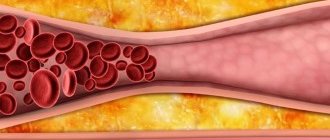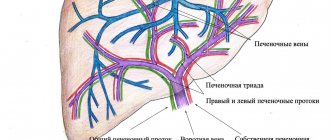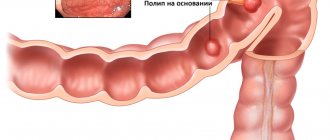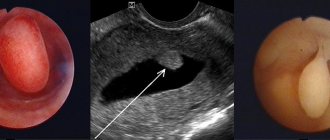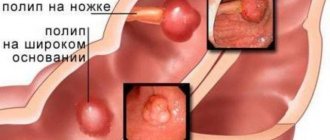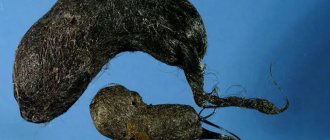A gastric polyp is a benign formation on the gastric mucosa. It is rare and usually does not manifest itself clinically. Most often it is discovered by chance during examination for other reasons.
The size of stomach polyps ranges from 0.5 to 8-10 cm. They can develop in any area of the stomach, but most often they are localized in the pylorus - near the exit from the stomach, where the duodenum begins.
Most polyps are benign, although some increase the risk of developing stomach cancer. Treatment of such polyps involves their removal; in other cases, the doctor is limited to observation only.
Polyps in the stomach
What causes the development of polyps in the stomach?
The content of the article
A stomach polyp develops when the mucous membrane of this organ is damaged. What increases the likelihood of its occurrence the most is:
- Chronic gastritis
. Chronic inflammation of the stomach leads to hyperplasia of polyps and adenomas. Hyperplastic polyps are less susceptible to malignant transformation, but if the lesion is larger than one centimeter, the risk increases. Adenomas are the most susceptible to malignant neoplasms among polyps. Because of this, it is recommended to remove the adenoma. Fortunately, adenoma is the rarest form of gastric polyp. - Familial polyposis
. This disease has already been mentioned in the review of colorectal polyps. In this rare congenital pathology, polyps also arise from the fundus of the stomach. These polyps are also characterized by malignancy. Familial polyposis also causes the development of adenoma, so treatment is also surgical. - Regular use of certain medications for stomach upset
. The occurrence of polyps can be promoted by proton pump inhibitors taken to reduce the acidity of gastric juice. In this case, the polyps are small and usually do not cause dangerous complications, but if they increase in size, the risk of malignancy increases, so if such polyps are present, the gastroenterologist will either change the medicine that caused the polyp, or suggest removing the polyp, or both.
Disease prevention
The risk of new polyps will help reduce:
- Timely treatment of gastritis, gastric ulcer. Regular examination by a gastroenterologist for existing chronic diseases of the gastrointestinal tract;
- Elimination of Helicobacter pylori infection: treatment must be under the supervision of a specialist;
- Revision of drug prescriptions in favor of forms of drugs that are safer for the stomach;
- Refusal of self-medication, uncontrolled taking of pills;
- Reducing the amount of alcohol consumed, giving up strong alcoholic drinks, smoking;
- A balanced diet with a predominance of boiled and steamed food, fresh vegetables and fruits. Reducing the amount of hot spices and too hot food.
Who is at risk from polyps?
Polyps are most often found in middle-aged and elderly people. Their appearance is expected when infected with Helicobacter pylori, since this bacterium increases the risk of developing chronic gastritis, and gastritis is considered one of the causes of polyps.
Multiple polyps are five times more likely to cause malignancy than single polyps. There is a close relationship between the size of the polyp and the risk of malignant neoplasm - a formation with a diameter of 1.5 cm is repeated in malignant disease in 6.8% of cases, and with a diameter of 3 cm - in 73.7%. Polyps with flat stalks are three times more likely to become cancerous than polyps with long stalks.
Rehabilitation
Recovery takes place under constant medical supervision. If endoscopic intervention was performed to cut off a benign polyp, the first control gastroscopy is done two weeks later. For cavity removal of adenomatous neoplasms - when the incision has completely healed. The basis of patient rehabilitation is diet. In the first month, the patient is allowed only liquid porridges and pureed soups. Then he is transferred to dietary table No. 1 for people with gastrointestinal diseases.
The basis of the diet of a patient with adenomatous benign neoplasms is:
- vegetable broth soups;
- meat, low-fat fish;
- dried white bread;
- soft-boiled eggs (steam omelet);
- porridge with milk or water;
- sweet berries, fruits;
- fermented milk products with a low fat content.
Dishes need to be boiled, baked, steamed. Boil vegetables and pasta well and grind in a blender.
The following sweet desserts are allowed:
- cookie;
- jam;
- berry, fruit mousses, purees;
- cottage cheese;
- dry biscuit;
- paste;
- baked pies;
- honey;
- marshmallows
You need to eat sweets little by little, 2-3 times a week. It is permissible to diversify the menu with light sour cream sauces, adding a small amount of dill and parsley.
Prohibited for patients with gastric adenoma:
- fatty meat, fish, lard;
- baking from yeast dough;
- legumes;
- marinades;
- cabbage;
- canned food;
- mayonnaise;
- fast food;
- pickles;
- semi-finished products;
- radish, radish;
- citrus;
- confectionery;
- hot, spicy sauces.
Tea and coffee are allowed to be drunk occasionally, weak, with the addition of milk. Carbonated and alcoholic drinks should be replaced with natural sweet juices (not packaged), fruit drinks, and rosehip decoction.
During the first time after surgery to cut off benign adenomatous polyps of the stomach, patients are prohibited from taking a hot bath, lifting weights, or playing sports. Any discomfort or pain in the area of the affected organ should be reported to your doctor immediately. Drug therapy is used only as recommended by a doctor. Self-administration of any medications can provoke recurrence of adenomatous neoplasms. If necessary, the patient will be prescribed a course of physiotherapeutic procedures.
How do polyps appear in the stomach?
Stomach polyps are most often asymptomatic, although they may cause abdominal pain or indigestion. As the polyp grows, ulcers may appear on the surface of the stomach with pain, nausea, bloody stools or vomiting, and signs of anemia.
Pain due to polyps in the stomach
In rare cases, the polyp affects the gap between the stomach and the small intestine or the lumen of the duodenum, which leads to severe pain and obstruction.
The diagnosis of gastric polyp is made by endoscopic examination. During the examination, a biopsy may be done - a sample of polyp tissue is taken for morphological examination.
Diagnostics
Endoscopic examination of the stomach (FGDS) allows diagnosing pathology and determining the histotype of the tumor. Using gastroscopy, you can study in detail the condition of the organ mucosa, detect adenomas even smaller than 5 mm, evaluate the structure of each neoplasm and take histological material for analysis.
Diagnostics also includes a survey and examination of the patient, fluoroscopy of the stomach with contrast, general clinical tests, laboratory tests and other techniques. If a malignant process is confirmed, further examination and treatment is carried out by an oncologist.
Treatment of polyps in the stomach
As mentioned, treatment for polyps depends on their type, size and number.
Small polyps that are not adenomas do not always require treatment, although neither one nor the other should be allowed - observation is necessary. So you will need to periodically undergo endoscopic examination by a gastroenterologist. If the polyp begins to grow or is detected clinically, it must be removed.
Antibacterial therapy is necessary for chronic gastritis and Helicobacter pylori infection. This will prevent the formation of polyps and may even cause hyperplastic polyps to disappear.
Antibacterial therapy for chronic gastritis
Large polyps and adenomas must be removed surgically. Polypectomy in this case is also performed during endoscopy. The introduction of this technique has greatly simplified the treatment of gastric polyps.
Classification
These formations that grow in the stomach can be divided into two large groups.
Hyperplastic polyps are the most common. They consist of epithelial tissue, which for some reason has grown and increased in volume. They cannot be considered a true tumor. In the stomach, such formations usually do not degenerate into malignant ones.
Adenomatous polyps arise from glandular cells. They are true tumors and have a high risk of developing into cancer. Especially if such a formation is larger than 20 mm.
Gastric polyps of this type can be divided into tubular, papillary and papillotubular. Their type can be determined only after a biopsy and histological examination of the tissue.
Also, these formations can be single or multiple, and are classified by size.
Polyps in the gallbladder
If you have an abdominal ultrasound report with suspected gallstone disease, and in the doctor’s report you read “polyps” instead of “stones,” do not be surprised - polyps in the gallbladder are not uncommon. According to statistics, gallbladder polyps occur in 0.3-9.5% of the population, although this condition is rarely detected clinically. Potentially dangerous formations are even rarer - 95% of gallbladder polyps are benign.
Polyps in the gallbladder
The cause of polyps in the gallbladder is unknown. We also don't know anything about risk factors. Scientists have not yet established a link between gallbladder polyps and age, gender, genetics or other factors that contribute to the development of gallbladder disease in general: obesity, diabetes, high cholesterol.
Clinical signs are thought to be rare. It also happens that the patient complains of nausea or vomiting, pain in the right navel, although polyps are most often detected by ultrasound for other reasons.
The size of the neoplasm indicates the ability of the polyp to assimilate. Tumors smaller than 1.3 cm in diameter are usually harmless and do not require treatment. However, this does not mean that we have the right to relax - the size of the polyp must be constantly monitored. Control is carried out by standard or endoscopic ultrasound examination.
If the growth of the polyp in the gallbladder exceeds 1.3 cm, we may already be dealing with a malignant tumor or the polyp may soon develop into such a disease. Polyps with a diameter of more than 1.9 cm are most likely already malignant.
Traditional methods
Traditional methods should be treated with caution.
You must always remember that any disease cannot be treated on your own; you should definitely consult a doctor. After all, self-medication may not only not help, but may further aggravate the course of the disease.
Therefore, folk methods should be treated with caution and used only in conjunction with treatment under the supervision of a specialist.
You need to talk to your doctor about everything you do so that he can approve it. You should discuss with him the dosage and formulation of all folk remedies. But most often, additional treatment will not be superfluous, therefore, in addition to treatment in special institutions, traditional therapy is used. It has a good effect on the treatment of celandine.
You need to pour one tablespoon of this herb with 200 grams of boiling water and let it steep for about an hour. The resulting decoction should be strained and taken 30 minutes before meals. You can also use propolis. It should be mixed with alcohol and left in a dark place for 7 days.
The tincture should be taken an hour before meals. Be sure to consult your doctor about the recipe, because everything can be selected individually; you should not be treated without the help of a specialist.
In this disease, diet plays a big role. You will have to give up coffee, fried, spicy, salty foods, as well as alcohol. You need to maintain a balanced diet, eat small portions as often as possible. The following products are allowed:
- Boiled vegetables.
- Pasta and porridge.
- Non-acidic fruits.
- Homemade juice or mineral water.
- White bread.
- Dairy products.
- Boiled meat or fish.
- Soups with vegetables or cereals.
Tactics for treating polyps in the gallbladder
The treatment tactics for the gallbladder are also determined by the size of the polyp. Monitoring is sufficient for small polyps; treatment of large polyps involves a simple operation - laparoscopic cholecystectomy, excision of the gallbladder. The operation is performed under general anesthesia, the risk of complications is minimal, and the result is very good.
Laparoscopic cholecystectomy
Resection of the gallbladder is recommended even when the polyp is accompanied by cholelithiasis. In this case, the size of the polyp is no longer given special attention.
